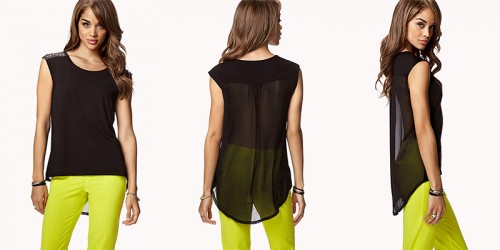Cruelty-Free Back-to-School Shopping Guide
 (Studded Chiffon Back Top featuring faux leather shoulder patches by Forever 21)
(Studded Chiffon Back Top featuring faux leather shoulder patches by Forever 21)
It’s been said that fashion is a reflection of your attitude and personality – that it can be a representation of your worldview. Wearing cruelty-free clothing is the fashion-forward way to show the world that you’re compassionate towards animals.
Many PETA-approved fashion labels have made the commitment to sell only clothes, shoes and accessories that contain no leather, fur, wool, skins, exotic skins or any other animal-derived fabric. But you don’t have to limit yourself to buying your threads from these labels, although we do strongly suggest that you give them a look. You can also buy trendy, fashionable, reasonably priced, animal-friendly items on the high street. All you need to do is check the labels.
The following is a list of vegan-friendly materials you can buy and animal-derived materials to avoid that are commonly found in clothes, shoes and accessories. This is not an exhaustive list. If you come across a material that you’re unfamiliar with and that is not listed here, ask a store clerk or whip out your smartphone and do a quick search on the Internet. Shoes
- Vegan materials: synthetic or faux leather (including pleather), all other synthetic materials (including polyurethane), cotton, canvas
- Materials to avoid: leather, suede, alligator skin, snakeskin, kangaroo
- Tip: Look inside the heel or under the tongue to find this information.
Coats and Jackets
- Vegan materials: cotton, polyester, polyester fleece, faux fur, synthetic down, down alternative, PrimaLoft, Thinsulate, Gore-Tex, Polartec Wind Pro, Thermolite
- Materials to avoid: wool, fleece, down, fur, fur trim
Suits
- Vegan materials: polyester, linen, Tencel, cotton, recycled plastic, viscose, rayon
- Materials to avoid: wool
Jumpers
- Vegan materials: cotton, linen, polyester fleece, acrylic, cotton flannel, synthetic fabrics
- Materials to avoid: wool, angora, Pashmina, cashmere, shearling, camel hair, mohair, silk, alpaca
Blouses
- Vegan materials: nylon, polyester, rayon, cotton
- Materials to avoid: silk
Trousers
- Vegan materials: denim, cotton, twill, polyester, linen, microfibers, nylon, acrylic, rayon
- Materials to avoid: wool, silk
Purses and Wallets
- Vegan materials: synthetic or faux leather (including pleather), all other synthetic materials
- Materials to avoid: leather, suede, snakeskin
Scarves
- Vegan materials: polyester, fleece, acrylic, cotton, jersey, linen
- Materials to avoid: angora, Pashmina, cashmere, shearling, camel hair, mohair, alpaca, silk
Ties
- Vegan materials: nylon, polyester, rayon, cotton, microfiber
- Materials to avoid: silk
Not sure why you should avoid animal-derived materials and instead seek vegan options? Here’s why:
- Leather: Millions of cows, pigs, sheep and goats are slaughtered for their skin every year. They are castrated, branded and dehorned and have their tails docked – all without painkillers. Then they are trucked to slaughter, bled to death and skinned. Sign this pledge to go leather-free.
- Wool: Shearing sheep involves more than just a haircut. Because shearers are paid by volume rather than by the hour, they often work too fast and disregard the animals’ welfare. Sheep are routinely punched, kicked and cut during the shearing process. Much of the world’s wool comes from Australia, where tens of millions of sheep each year undergo “mulesing”, a gruesome procedure in which instruments resembling gardening shears are used to cut dinner plate–sized chunks of skin and flesh from the backsides of live animals – often without painkillers. Sign this pledge to go wool-free.
- Fur: Animals on fur farms spend their entire lives confined to cramped, filthy wire cages. Fur farmers use the cheapest, cruellest killing methods available, including suffocation, electrocution, gas and poison. Click here to ask Harvey Nichols to stop selling fur.
- Angora: Angora rabbits are strapped to a board for shearing, kicking powerfully in protest. The clippers inevitably bite into their flesh, with bloody results. Angora rabbits have very delicate foot pads, making life on a wire cage floor excruciating and ulcerated feet a common condition. Because male Angora rabbits have only 75 to 80 per cent of the fur yield of females, they are killed at birth on many farms. Click here to ask Benetton to ban angora.
- Down: Down is plucked from geese and ducks, either while they’re still alive or after slaughter. Many geese used for down are held down by workers, who tear out the birds’ feathers while the animals shriek in pain and terror. They are often plucked so hard that their skin rips open, leaving gaping wounds that workers crudely stitch back together in the same unsterile environment in which the birds were plucked – and all without any painkillers. Sign this pledge to go down-free.
- Silk: Silk is the fibre that silkworms weave to make cocoons. To obtain silk, worms are steamed or gassed alive in their cocoons by manufacturers. For more information, read this article.
- Exotic skins: “Exotic” animals, such as alligators, are factory farmed for their skin and meat. They may be beaten to death with hammers and axes, sometimes remaining conscious and in agony for up to two hours after they’re skinned. Snakes and lizards may be skinned alive because of the belief that live-flaying makes exotic leather more supple. Pledge to shed exotic skins from your wardrobe.
- Shearling: A shearling garment is made from a sheep or lamb who is shorn only once before slaughter. The animal is then skinned, and shearling is made from the skin with the wool still on it. It can take 25 to 45 individual sheep hides to make just one shearling garment. Sign this pledge to go wool-free.



